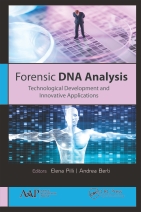|
|
Reviews “Provide[s] an overview of new technologies and current applications in forensic genetics. It accomplishes this with chapters on genome structure and DNA polymorphisms and the different classes of biomarker types that have current forensic utility. Novel technologies and techniques in forensic genomics are addressed by the authors on topics including MPS, phenotypic traits and bio-geographical ancestry. Pleasingly, the book recognizes that human forensic geneticists do not operate in a vacuum and are not the only people who deal with biological material, and hence, chapters on forensic anthropology, entomology, wildlife forensics, and molecular autopsy of sudden cardiac death are included. Uniquely, a voice is given to a number of commercial vendors with scientific descriptions of their innovative technologies. Prospective readers who would benefit from reading the book, or chapters therein, include forensic geneticists and other forensic specialists who desire up to date reviews on the state of the art in forensic genomics, criminal justice professionals including trial attorneys, and educators and their students.” —From the Foreword by Jack Ballantyne, University of Central Florida, Orlando, Florida, USA Forensic DNA Analysis: Technological Development and Innovative Applications provides a fascinating overview of new and innovative technologies and current applications in forensic genetics. Edited by two forensic experts with many years of forensic crime experience with the Italian police and with prestigious academic universities, the volume takes an interdisciplinary perspective. It presents an introduction to genome polymorphisms, discusses, forensic genetic markers, presents a variety of new methods and techniques in forensic genetics, and looks at a selection of new technological innovations and inventions now available from commercial vendors. CONTENTS: About the Authors / Editors: Editors: Elena Pilli, PhD Forensic Molecular Anthropologist and Captain of the Italian Military Police “Carabinieri,” Forensic Scientific Centre, Rome, Italy. Elena Pilli, PhD, is a Forensic Molecular Anthropologist and Captain of the Italian Military Police “Carabinieri” at the Forensic Scientific Centre in Rome, Italy, since 2017, a reserve officer selected by CV for her molecular anthropological competence. Prior to that, she was Head of the Forensic Molecular Anthropology Unit of the Department of Biology at the University of Florence, Italy. She was Professor of Forensic Genetics at the Master School in Technologies and Applications for scientific investigations at the University of Florence. An expert in analysis of DNA extracted from highly degraded samples, such as human and animal bones and teeth and human and animal hair, Dr. Pilli was involved in several important cold cases of national interest. She was also in charge of the identification of the Fallen at the Fosse Ardeatine (a mass grave national case), and she was recently involved in identification of human remains of Strage di Bologna (terroristic attack occurred in 1980). The author of approximately 40 publications in national and international scientific peer-reviewed journals and author of several book chapters, she was recognized for her scientific research for a Science Breakthrough of the Year. She is a reviewer of international journals, such as PLos One, BMC Genetics, and Scientific Reports. Her PhD was earned in biology, anthropology, and primatology. In 2018 she achieved the National Scientific Qualification as Associate Professor in Zoology and Anthropology. Andrea Berti, PhD Forensic Biologist and Lgt. Colonel of the Italian Military Police “Carabinieri,†Forensic Scientific Centre, Rome, Italy Andrea Berti, PhD, is a Forensic Biologist and Lgt. Colonel of the Italian Military Police “Carabinieri†at the Forensic Scientific Centre in Rome, Italy. He has been working in a forensic DNA laboratory since 1997 and has been the Technical Manager of the Forensic Biology Unit since 2010 (accredited ISO:IEC 17025 since 2012). The biology unit works on approximately 1,400 crime cases each year that occur in central and southern Italy, handling about 3,000 items of forensic evidence and performing 20,000 DNA analyses each year. The unit also employs NGS technology for forensic applications. Dr. Berti is certified as a BPA analyst and internal auditor for QA in forensics. He is a member of many professional organizations and is co-author of more than 40 articles published in forensic journals. Since 1999, Dr. Berti has been a trainer to the Italian military academy for forensic crime scene investigation and DNA analysis. He is also involved in managing the Italian DNA database as a CODIS supervisor. |

 Follow us for the latest from Apple Academic Press:
Follow us for the latest from Apple Academic Press:
New Book Series: AAP Series on Waste Biomass Valorization will explore the transformation of biomass resources into valuable products, addressing the growing need for sustainable alternatives to fossil fuels and non-renewable resources. This series sits at the intersection of environmental science, renewable energy, and sustainable development, highlighting the potential of biomass conversion technologies to mitigate climate change, reduce waste, and foster economic growth. By converting biomass waste streams into biofuels, bioproducts, and bio-based materials, this series seeks to offer innovative solutions to pressing environmental and societal challenges. For more information and to propose a book, please visit: Click here
Congratulations to Hafiz Ansar Rasul Suleria, PhD, for receiving the Dean’s Award for Excellence in Research from the University of Melbourne, Australia, in recognitation for his exceptional performance and strong commitment to advanced research in food science. Dr. Suleria is editor of AAP’s book series Innovations in Plant Science for Better Health: From Soil to Fork. For more information, visit: Click here Congratulations to Dr. Christian Mancas. His book Conceptual Data Modeling and Database Design: A Fully Algorithmic Approach was one of the 6 Best Data Modeling ebooks for Beginners by BookAuthority, a leading site for book recommendations. For more information, visit: Click here Announcing a new book series: AAP Insights in Women’s and Gender Studies: Reshaping Identities is on a mission to revolutionize the conversation around gender, identity, and societal dynamics. The series aims to bridge the gap between academic rigor and practical application, providing tools that empower educators, researchers, students, and activists to spark change and advance the cause of gender equality around the world. For more information, visit: Click here AAP Editor & Author Dr. Wasim Siddiqui to Lead the World Food Preservation Center, USA AAP congratulates Professor Mohammed Wasim Siddiqui on this new and prestigious appointment. In this role, he directs the planning, development, and implementation of plans within the organization, which is dedicated to reduction of postharvest food loss and wastage. Dr. Siddiqui will also originate and promote existing initiatives of the sister universities and institutes of the World Food Preservation Center® LLC. Dr. Siddiqui is editor of two book series with AAP. For more information, visit: Click here Announcing a new AAP book series: Perspectives and Anthropology in Tourism and Hospitality (PATH) For more information, visit: Click here The new AAP book series Innovations in Microbiology welcomes book proposals. For more information, see: Click here COMMENTS FROM AAP EDITORS AND AUTHORS AAP book title: Advances in Audiology and Hearing Science (2-volume set) “I have collaborated with AAP during the process of bringing my two-volume editing work " Advances in Audiology and Hearing Science" to a final publishing phase. Despite the fact that the book brought together 41 different authors (with very different writing styles), AAP support has been truly important throughout the initial and final stages of the book. While the majority of the publishing work is done at the early stages, the final touches that include the last-minute corrections of the authors are extremely crucial to the quality the book tries to convey. The assistance of AAP during the last stages of corrections and communication with the authors was a very positive contributor to my state of mind during those stressful moments. I recommend the publishing experience with AAP to other editors of scientific material.” —Stavros Hatzopoulos, PhD, Hearing Science Laboratory, University Hospital of Ferrara, Ferrara, Italy AAP book title: Nanotechnologies: The Physics of Nanomaterials (2-volume set) “As the author of a two-volume book on nanotechnologies, I was very pleased with the interaction and support of the team at Apple Academic Press. They provided me with regular and useful information and updates throughout the publishing procedure. I am also very happy with the final product, which is of good quality. The books are now available and are professionally distributed through the various channels. I would like again to thank the team at AAP for all their hard work and support.” —David Schmool, PhD, Director, Groupe d’Etude de la Matière Condensée GEMaC, National Centre for Scientific Research, Université de Versailles/Saint-Quentin, Université Paris-Saclay,Versailles, France AAP book title plus many others: Physiology of Molluscs (2-volume set) “Since my first recent association, I have enjoyed the full benefit of support, encouragement, and kindness from the members of AAP I have had the pleasure of being associated with. In the same vein, I hope AAP was satisfied with the book series I have edited in advancing the knowledge. It has been a great journey and was a great pleasure and satisfaction. Advancing scholarship through publications is one of the best routes publishers can take, and I would hold AAP as one of the best ones.” —Saber Saleuddin, PhD, University Professor Emeritus, Department of Biology, York University in Toronto, Ontario, Canada AAP book title plus many others: Green Chemistry and Sustainable Technology: Biological, Pharmaceutical, and Macromolecular Systems “It had been my pleasure to work with the production team of Apple Academic Press for almost a decade. The best presentation of our work was due to their hard work and with careful scrutiny. I am sure that every one of them takes extra pains to publish the book nicely, maintaining the quality and timeliness. It was a rewarding experience to work with AAP. I would like to publish more with AAP on my upcoming projects in future also.” —Prof. Suresh C. Ameta, Professor of Eminence (Distinguished Professor), Faculty of Science, PAHER University, UDAIPUR, India AAP book title: New Frontiers in Nanochemistry, 3-volume set, plus many others "Publishing a book, either as author or editor, is a journey from the initial vibration to the piece of knowledge towards the present future of humanity at large. Such a journey is about climbing and tunneling, about diving and driving through, about inspiration and tuning, about hard working in every instance; and it is also about time. Very few Global Publishers have the wisdom and patience and kindness and openness to authors, contributors, and readers while being truly crafting oriented as Apple Academic; yet all is about people and their education, vision and assumed mission; the Apple Academic Team heartily succeed that in achieving the world class scholarly acclaim by the quality involvement in all chain of plus value added with each publishing event. Hearty Compliments! Excelsior Apple Academic!" —Mihai V. Putz, PhD, Dr.-Habil., MBA, Professor, Faculty of Chemistry, Biology, Geography, Laboratory of Computational and Structural Physical Chemistry for Nanosciences and QSAR, West University of Timi?oara; PI-1, Laboratory of Renewable Energies - Photovoltaics, National Research and Development Institute for Electrochemistry and Condensed Matter (INCEM), Timi?oara, Romania AAP book title: The Chemical Century: Molecular Manipulation and Its Impact on the 20th Century “All my experiences with AAP have been very positive. I entrusted AAP with the publication of The Chemical Century: Molecular Manipulation and Its Impact on the 20th Century and found the quality of the book that they produced to be excellent. My two contacts at the company were very responsive and efficient throughout the publication process.” —Richard J. Sundberg, PhD, Professor of Chemistry, University of Virginia, Charlottesville, Virginia, USA AAP book titles: Medical Tourism and Wellness: Hospitality Bridging Healthcare (H2H)© and Medical Travel Brand Management: Success Strategies for Hospitality Bridging Healthcare (H2H) “I have enjoyed my scholarly creative work with Apple Academic Press. They have been timely, creative, and very helpful for my two books with them. I encourage you to consider publishing your work with AAP.” —Frederick DeMicco, PhD, RDN, Executive Director and Professor School of Hotel and Restaurant Management, Northern Arizona University, Flagstaff, Arizona AAP book title: Coping with Biological Growth on Stone Heritage Objects: Methods, Products, Applications, and Perspectives “It was a wonderful day when, some years ago, AAP accepted to publish the book on which I’ve been working for years. My experience was very good and confirms that AAP is a publisher of quality and looks for quality books. Everyone on the AAP team gave me the utmost care for which I will always be grateful. They took the time to discuss my proposal. This meant transforming some aspects and changing the proposal, but it made for a stronger and better book. I really appreciated the team members for outstanding performance and the skills they used to achieve that performance. I am very thankful for their help and effort, for their professional guidance and assistance.” —Daniela Pinna, Department of Chemistry, University of Bologna, Italy AAP book title: The Chemical Evolution of Phosphorus: An Interdisciplinary Approach to Astrobiology “I’m very pleased with the books you have edited. It shows a very good and careful work by everyone involved along the whole production process, and so the final result is a beautiful piece: it has come out as a very nice and appealing book, easy to handle and read, .... and hopefully of interest for people from diverse related fields!” —Enrique Macia-Barber, PhD, Professor of Condensed Matter Physics, Universidad Complutense de Madrid, Spain |



